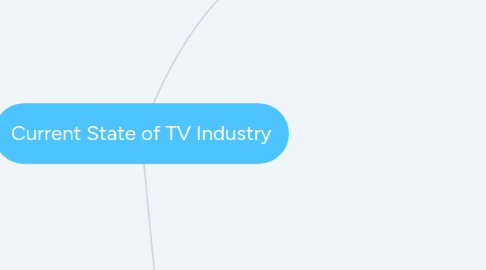
1. New digital platforms
1.1. Alternate viewing
1.1.1. Streaming services
1.1.1.1. Netflix
1.1.1.1.1. It's available 24/7 to watch programs and movies. There's no limitation on how much you can watch
1.1.1.1.2. creates their own programs as well as features other movies and shows
1.1.1.1.3. monthly rate of as low as $7.99 and it's highest package offer of $13.99 so it's inexpensive compared to cable
1.1.1.2. Hulu
1.1.1.2.1. it's available 24/7 to watch programs and movies. There's no limitation on how much you can watch
1.1.1.2.2. creates their own programs as well as features other movies and shows
1.1.1.2.3. $5 a month for students when they buy Spotify Premium this is a good deal for students that makes digital content accessible
1.1.1.2.4. Regular Hulu membership is $5.99 a month which is cheap in comparison to the price of cable packages
1.1.1.3. Amazon Prime
1.1.1.3.1. it's available 24/7 to watch programs and movies. There's no limitation on how much you can watch.
1.1.1.3.2. creates their own content. Features shows and movies available to prime customers
1.1.1.3.3. Prime is available for $99 a year or $10 a month which is cheap in comparison to cable packages- with the added benefit of giving amazon customers their packages faster.
1.1.2. Recording
1.1.2.1. DVR's are able to record live shows so viewers can watch it later
1.1.2.2. doesn't require viewers to be present to record, they can do it electronically
1.1.3. Video on Demand
1.1.3.1. With certain cable packages (Comcast/ Xfinity) people can watch shows that have recently aired the next day for free and sometimes they'll stay on the platform for awhile
1.2. Communal viewing: people interact with their online communities about the show and make commentaries about their opinions, fan theories, and other exclamations about the show their watching. This fosters a new type of environment for viewers-- one that hasn't been present before
1.2.1. social media impacts how we view shows
1.2.1.1. Twitter
1.2.1.1.1. high emotion dramas (scandal) inspire people to take to twitter to tweet about their experience watching the show, and thus take part in communal viewing
1.2.1.2. Facebook
1.2.1.2.1. a place to foster cultural discussions amount similarly minded people (people who watch the same shows
1.2.1.3. snapchat
1.2.1.3.1. actors and producers take to snapchat with sneak peaks and short behind the scenes or trailers that create sparks of interest for the show.
1.3. benefits of new digital platforms
1.3.1. Bingewatching
1.3.1.1. With cable television shows are released once a week, which leaves viewers in anticipation for a week, and while this was good for the initial release of television, nowadays we live in an instantaneous world where people want everything right away.
1.3.1.2. by utilizing streaming services people can watch an entire season in one sitting. This kind of viewing some find preferable so that they don't lose anything in the week that comes between episodes.
1.3.2. elmination of prime time
1.3.2.1. with shows available 24/7 people can watch their shows at their own convenience, they don't have to wait for good shows to come on at night.
1.3.3. choice of content
1.3.3.1. with streaming services people can chose what they want to watch- with cable television while viewers have a choice in what programs to watch, if they are only available to watch TV from 8-9, they can chose any channel they want to watch but the programs may not be favorable to that viewer.
1.4. drawbacks from cable
1.4.1. cable television is confined to the TV so viewers must reamain in one spot to watch their programs (typically the family room) whereas with streaming services and devices people can take their viewing on the go.
1.4.2. With cable viewers have to share the one TV among multiple member of the family, but with streaming and tablet devices/phones people can watch their own shows on their own devices in their own space.

